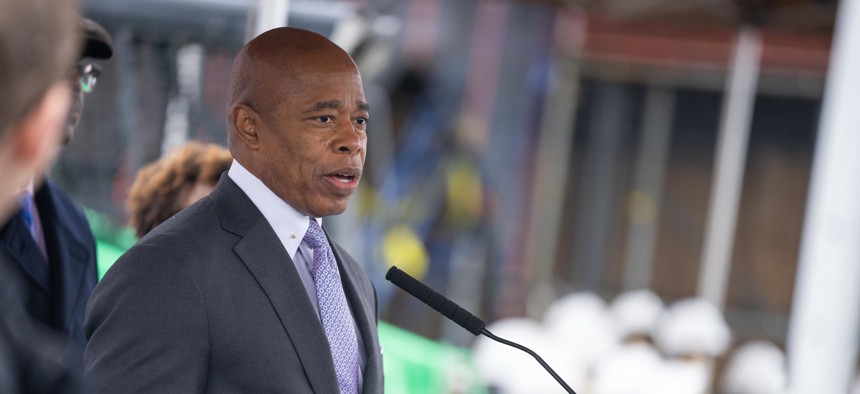NYC Faces Fiscal Disaster if Officials Think They Can Do It All

Ed Reed/Mayoral Photography Office
COMMENTARY | Undisciplined management and a spending spree in Mayor Eric Adams’ upcoming fiscal year 2023 budget will set the city back.
The next stop of budget season is New York City Mayor Eric Adams executive fiscal year 2023 budget, to be released April 26. It’s a pivotal moment. The choices made, along with the outcomes of city labor negotiations, will reverberate for years to come.
Spending a lot more now is seductive, but shortsighted. The city’s leaders should not pretend that the city can have and do it all. Undisciplined management and a spending spree will set the city back, not propel it forward.
Consider this future – the existing $3 billion budget gap, $4 billion or more in employee raises and $2 billion fiscal cliff together are a $9 billion recipe for fiscal disaster by 2026 if nothing is done. Of course, this doesn’t account for another recession, which could produce a three-year revenue shortfall of $17 billion, based on the past.
This isn’t some “sky is falling” worst case scenario. It’s a reasonable portrait of inaction.
The only way to balance the important needs of New Yorkers today and in the future, when the city will face the inevitable next recession or emergency, is to prioritize programs, increase the efficiency and quality of services, and save for a rainy day. Absent these actions, the city will face future massive service cuts or harmful tax increases, and city workers will only get raises at the expense of services and reductions in force.
It is easy to get distracted by the fiscal wind in the mayor’s sails – strong revenues, federal COVID-19 aid and modest $2 billion to $3 billion annual budget gaps beginning in fiscal year 2024. However, the waters ahead are palpably rough – fiscal cliffs previously built into the budget, unfunded labor contracts, new priorities and a City Council list totaling over a billion dollars. Add to this a rocky recovery, inflation, global instability and economic changes like remote work that will affect commercial real estate and may dampen future income taxes.
What to do next?
First, the mayor and council must resist the temptation to use additional tax revenue to expand services. This money should be deposited into the Rainy Day Fund (RDF) for the next recession and help refill the city’s labor reserve, the down payment on future employee raises that was cut during the recession. The city also should schedule $500 million annual deposits to the RDF, which could come from the budgeted General and Capital Stabilization Reserves.
Second, the executive budget should address the budget’s fiscal cliffs where ongoing programs are funded with nonrecurring city and federal COVID-19 funds. These cliffs total $900 million next year and nearly $2 billion by fiscal year 2026, according to the state comptroller’s office.
For next year, this means deciding whether or how to fund prevailing wages for shelter security staff, more generous city housing vouchers, additional street wastebasket collection, The Journey Home program and more. This budget also is the time to start addressing those future cliffs, which the expansion of education for 3-year-olds and other programs will tumble off. Any program prioritized to continue must be supported by recurring funding, and that has to come from somewhere.
Increasing this challenge is the call by some to continue temporary programs funded with one-time federal COVID-19 aid. To be clear, this aid was intended for pandemic mitigation, short-term relief and to bolster recovery, not to increase ongoing city services. Some mischaracterize the tapering of federal aid as budget cuts, which misconstrues this federal intent and aid structure. Shifting these programs to city funds will further bust a budget that already has gaps.
Therefore, third, the city must lower costs, ideally by improving efficiency or by reducing lower impact programs. Unfortunately, the city does not appear to have heeded our call for a 3% Program to Eliminate the Gap for Productivity in the executive budget, which would save about $1.5 billion annually. Still, there is plenty of time to identify these savings before the budget is adopted. The city should reduce costs without reducing services by streamlining processes, leveraging technology and fostering cross-agency collaboration that eliminates redundancy.
Finally, the city should use this next round of collective bargaining contracts to further increase productivity, which would generate savings to fund raises and stabilize the budget. Almost all city employees will be working under expired contracts by the end of the year. The tight job market and high inflation may increase municipal unions’ demands. Raises totaling 3% annually would cost about $1.5 billion in the first year, increasing to $4.3 billion in the third year. While a portion of a PEG for Productivity and higher tax revenue could defray some collective bargaining costs, much more will be needed, otherwise raises will be unaffordable.
After hopefully proposing an executive budget that shrinks the cliffs, saves for a rainy day and increases productivity, the mayor should stand firm on spending. The adopted budget usually is $1.4 billion larger than the preliminary budget. Hopefully the council supports these directions in negotiations; our future depends on it.
Ana Champeny is the deputy research director at the Citizens Budget Commission.





